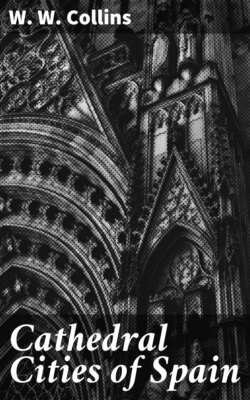Читать книгу Cathedral Cities of Spain - W. W. Collins - Страница 3
На сайте Литреса книга снята с продажи.
PREFACE
ОглавлениеTable of Contents
SPAIN, the country of contrasts, of races differing from one another in habits, customs, and language, has one great thing that welds it into a homogeneous nation, and this is its Religion. Wherever one's footsteps wander, be it in the progressive provinces of the north, the mediævalism of the Great Plain, or in that still eastern portion of the south, Andalusia, this one thing is ever omnipresent and stamps itself on the memory as the great living force throughout the Peninsula.
In her Cathedrals and Churches, her ruined Monasteries and Convents, there is more than abundant evidence of the vitality of her Faith; and we can see how, after the expulsion of the Moor, the wealth of the nation poured into the coffers of the Church and there centralised the life of the nation.
In the mountain fastnesses of Asturias the churches of Santa Maria de Naranco and San Miguel de Lino, dating from the ninth century and contemporary with San Pablo and Santa Cristina, in Barcelona, are the earliest Christian buildings in Spain. As the Moor was pushed further south, a new style followed his retreating steps; and the Romanesque, introduced from over the Pyrenees, became the adopted form of architecture in the more or less settled parts of the country. Creeping south through Leon, where San Isidoro is well worth mention, we find the finest examples of the period in the eleventh and twelfth centuries, at Segovia, Avila, and the grand Catedral Vieja of Salamanca.
Spain sought help from France to expel the Moor, and it is but natural that the more advanced nation should leave her mark somewhere and in some way in the country she pacifically invaded. Before the spread of this influence became general, we find at least one great monument of native genius rise up at Tarragona. The Transition Cathedral there can lay claim to be entirely Spanish. It is the epitome and outcome of a yearning for the display of Spain's own talent, and is one of the most interesting and beautiful in the whole country.
Toledo, Leon, and Burgos are the three Cathedrals known as the "French" Cathedrals of Spain. They are Gothic and the first named is the finest of all. Spanish Gothic is best exemplified in the Cathedral of Barcelona. For late-Gothic, we must go to the huge structures of Salamanca, Segovia, and the Cathedral at Seville which almost overwhelms in the grandeur of its scale.
After the close of the fifteenth century Italian or Renaissance influence began to be felt, and the decoration of the Plateresque style became the vogue. San Marcos at Leon, the University of Salamanca, and the Casa de Ayuntamiento at Seville are among the best examples of this. The influence of Churriguera, who evolved the Churrigueresque style, is to be met with in almost every Cathedral in the country. He it is who was responsible for those great gilded altars with their enormous twisted pillars so familiar to travellers in Spain; and which, though no doubt a tribute to the glory of God, one feels are more a vulgar display of wealth than a tasteful or artistic addition to her architecture. The finest of the Renaissance Cathedrals is that of Granada, and the most obtrusive piece of Churrigueresque is the Cartuja in the same city.
Taking the Cathedrals as a whole the two most unfamiliar and notable features are the Coros or Choirs, and the Retablos. These latter—gorgeous backings to the High Altar, generally ill-lit, with a superabundance of carving sometimes coloured and gilded, sometimes of plain stone—are of Low-country or Flemish origin. The former, with one exception at Oviedo, are placed in the nave west of the crossing, and enclose, as a rule, two or more bays in this direction. Every Cathedral is a museum of art, and these two features are the most worth study.
NOTE.—Since the revolution in Catalonia of July-August 1909, the King has decreed that no one can secure exemption from military service by the payment of a sum of money.
